The best preparation for simulating skin diseases some sort of alien crud that nobody’s ever seen and look at the section on surface anatomy and skin, and you might come up with some ideas.
SKIN-SAFE SILICONE AND GELATIN
These two materials are absolute essentials for an artist’s kit. Skin-safe silicones are two-part (A-B) components that are mixed 1:1 by volume and can be applied directly to the skin, sculpted into a wound, burn, or the like, powdered, and then painted. These silicones set up in minutes and can feasibly be peeled off and used again later. There are three that I know of on the market currently, from Alcone, Smooth-On, and Mould Life, called Third Degree, Skin Tite®, and Sculpt Gel, respectively.
Gelatin is easy to use as an out of the kit material.
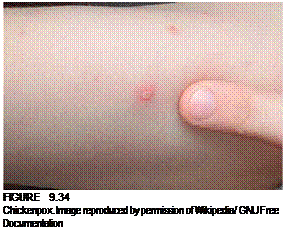
![]()
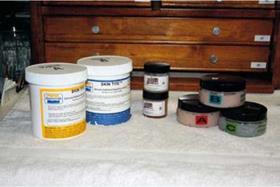

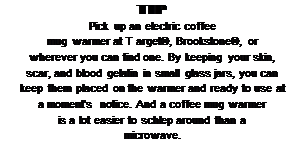 It needs to be heated so that it will melt and can then be applied directly to the skin; make sure that it’s not too hot. It will burn if it’s heated too much. You can also damage the gelatin itself by too much heat. Warm it just enough for it to melt. Blisters, scars, and the like are easy to create. When the gelatin is set, powder it to remove the stickiness. If you’re using gelatin blood,
It needs to be heated so that it will melt and can then be applied directly to the skin; make sure that it’s not too hot. It will burn if it’s heated too much. You can also damage the gelatin itself by too much heat. Warm it just enough for it to melt. Blisters, scars, and the like are easy to create. When the gelatin is set, powder it to remove the stickiness. If you’re using gelatin blood,
![]()
powdering it will remove the glossiness that wet blood would have, so don’t powder blood.
Before applying gelatin, apply a layer of Top Guard® or Pros-Aide® as a barrier layer to prevent perspiration from causing the gelatin to loosen. Refer back to Chapter 6 for more information on working with gelatin.
After reading this chapter, you should now know more about:
![]()
![]()
![]()
![]() Making bondo and its use as a prosthetic transfer material
Making bondo and its use as a prosthetic transfer material
How to make and apply a bald cap and some other uses for the different
types of bald cap plastic material
Making built-up ears and noses out of latex or plastic cap material
What Tuplast is
Using nose and scar wax
Making scars with rigid collodion
Tattoo and creature texture stencils
Why you should take an airbrush class
Making and using 3D prosthetic transfers
How to incorporate electrostatic flocking into your work
Applying latex age stipple
Collecting reference images for creating trauma, wounds, burns, and skin conditions
Working out of the kit with skin-safe silicone and gelatin
You will find some discrepancies among makeup artists about what is absolutely essential to have in your kit or at least in your possession. I have kits for different gigs as well as chests, cases, and bags of differing sizes, from countertop oak behemoths to over-the-shoulder canvas on-set bags and everything in between.
Gerstner & Sons of Dayton, Ohio, make well-crafted oak machinist chests that I’ve found to be excellent units for holding many of the items I use. They are available in numerous sizes and configurations, but they can be quite expensive. Harbor Freight carries a machinist chest that is also oak, versatile, and much less expensive than a Gerstner chest. RCMA used to sell nice makeup cases like these; I’m not sure if they still do or not.
Here is a partial list of items you will want to have in your kit; with them you will be armed with the tools to create virtually anything you are asked to create right out of the kit.
■ Makeup case
■ On-set bag
■ Brush holders
■ Brush roll
■ Misc. brushes
■ Latex triangle sponges
■ Orange sponge (porous synthetic rubber sponges might even be yellow)
■ Palette knife (plastic and metal)
■ Tissues
■ Misc. clips
■ Stipple sponges
■ Velour powder puffs
■ Tweezers (several sizes)
■ Hand mirror
■ Small sharp scissors
■ Utility scissors
■ Misc. combs; rattail comb
■ Misc. hair brushes
■ Cotton pads
■ Cotton balls
■ 
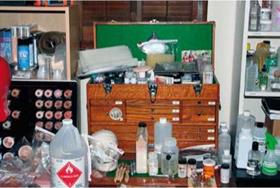
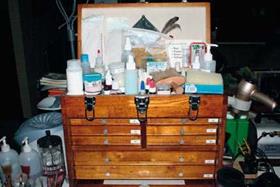

 |
Cotton swabs (Q-tips®)—round end, point end, flat end
■ Long cotton swabs
■ Bald cap head form
■ Brush cleaner (Parian Spirit) and container
■ Misc. plastic containers
■ 1 oz. and 2 oz. plastic cups for adhesives, etc.
■ Hair hackle
■ ![]()
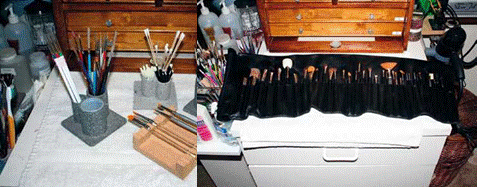 |
Drawing mats
■ Breath mints (seriously; I’m not kidding)
■ Purell or other hand sanitizer
■ Work towels
■ Paper mats
■ Makeup cape or cover cloth
■ Misc. spray bottles
■ Misc. hairclips
■ Misc. hair bands
■ Airbrush and compressor
■ Pipe cleaners
■ Misc. tooth brushes
■ Hair-thinning scissors
■ Small blow dryer
■ Misc. curling irons
■ Misc. flattening/straightening iron
■ Disposable lip gloss applicators
■ Disposable mascara brushes
■ Misc. syringes (without needles)
■ Nail clippers
■ Setting powder
■ Ninety-nine percent isopropyl alcohol
■ Telesis® 5 adhesive
Telesis® 5 thinner Telesis® Super Solv®
Pros-Aide® adhesive Isopropyl Myristate Blood
Misc. gelatin Rigid collodion Collodion remover Crepe hair (wool)
Coffee mug warmer Makeup sealer Plastic cap material Latex stipple Misc. creme foundations Styptic pencil Eye drops
Makeup pencil sharpener Disposable razors Shaving cream Skin moisturizer Skin cleanser Telesis® Top Guard®
Ben Nye® Bond Off!
Orangewood stick Misc. craft sticks Toothpicks Tuplast
Skin-safe silicone (3rd Degree; Skin Tite®, Sculpt Gel)
Disposable eyeliner brushes
Misc. eyebrow pencils
Skin Illustrator or Stacolor palettes
Bondo (Pros-Aide® and Cab-O-Sil®)
Cab-O-Sil®
Glycerin K-Y® lubricant Castor sealer
Latex, vinyl, or nitrile gloves Nose and scar wax
This page intentionally left blank
